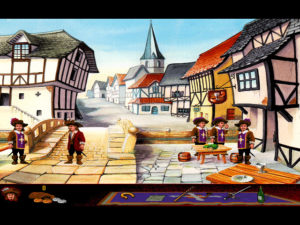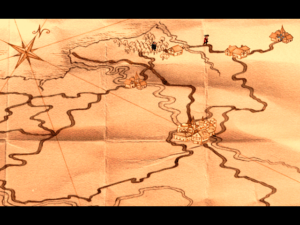Touché!: Conclusions
My journey through Geoffroi le Brun’s journey had a twist ending not found in the game itself.
The final confrontation with Cardinal de Guise takes place in William de Peuple’s castle, where every room is a point of no return, a gauntlet of puzzles where each new room shows the depths of the Cardinal’s villainy in progressively plainer terms, culminating in the conjuration of a skeleton army. Where Monkey Island had voodoo, Touché! has necromancy. It’s more incongruous here, though. The pirate tales that inspired Monkey Island were quite varied and had some intersection with stories of ghost ships, but all pop cultural ideas about Musketeers come from a single source, one which is by all accounts surprisingly true to history. The addition of magic to this setting reminded me of the Don Bluth cartoon Anastasia, which portrayed Rasputin as a sorcerer who brought about the fall of the Romanovs with his spells.
Several rooms before that, though, was a place where I got stuck. My inventory was fairly depleted by then, and there were only so many interaction points in the room, so it didn’t take long to exhaust my options. So I came to the unfortunate conclusion that I needed some undiscovered object left behind in the main part of France. After considering the few unresolved situations back there and the few inventory items I hadn’t found a use for yet, I reloaded a save and found the solution: I did indeed have a means of freeing that accused witch I talked about in the previous post. Furthermore, if I went back to an even older save, I could, as I had guessed, free her to bring back Atoff to administer my marksmanship test. In other words, the game is indeed Cruel (or possibly just Nasty; these gradations blur a bit at the edges), but for opposite reasons than I had thought. Atoff’s absence, which I had thought was a cause of deadlock, was actually an attempt at removing it, a way to guarantee that the player has the old woman’s reward before reaching the endgame. My replaying part of the game to avoid this limitation had backfired. And the Cruelty still seems to be accidental. The game otherwise takes care to make sure you have everything you need when you enter the endgame, even making Geoffroi refuse to give Henri two crucial items that he’ll need when Henri isn’t available.
Overall, I can’t really recommend this game to any but the most enthusiastic enthusiast. It’s not just that it’s not quite up to the standards of Monkey Island, it’s that it’s not up to the standards of other Monkey Island imitations. The humor is kind of weak, the characters are all a bit unlikable, and the puzzles get a little cat-hair-mustache at times. That is, it’s not nearly as nonsensical as the worst of The Watchmaker, but there are multiple bits that necessitate exhaustive guesswork — probably the worst is a part where you forge a key by coating your dagger in candle wax, inserting it into the keyhole to get an impression, and filing down the result. Not one step in that process makes sense. And yet, at the same time, it doesn’t often have the courage to go for the truly wacky adventure game puzzles, the kind that make you feel clever for getting inside the author’s headspace. Probably the closest it comes to that is the part where you repair Michaelangelo da Vinci’s experimental steamboat with random found items.
Also, there’s frequent mismatches between the art and the text or logic, as if there wasn’t a lot of communication between the artists and the writers. There are sundry little things like someone describing a man as “over by the door” when he clearly isn’t, or Geoffroi identifying a window of an inn as his room when it really should be around the other side. There’s a rope that’s being used to moor a boat when you take it, which is later shown as long enough to reach a cathedral ceiling and back multiple times. I’ve already mentioned the rampant asset reuse. There’s a scene that I found particularly striking in this regard, of people queued up in front of the Louvre, waiting to see the Chancellor. The game calls one of them a wealthy man, sumptuously dressed. Another is described as dressed all in black. Dialogue with these two people makes frequent mention of their distinctive clothing. Their sprites are identical.
I will say, though, that there’s something about this game that kept me going without rushing to get it over with for a long time, longer than the other point-and-click adventures I’ve been playing lately. Maybe just the clarity of the art, or the resemblance to fondly-remembered games of yore.
One last thing I’d like to note: the role of swashbuckling. I haven’t commented on it before, because it plays such a strangely minor role for a story about Musketeers, but there are in fact multiple places where Geoffroi can brandish his sword — and usually lose. He seems to be able to hold his own against single opponents, but he’s usually outnumbered. What’s really notably absent, though, is any sort of swordfighting mini-game. When you want Geoffroi to fight someone, you just click his sword from his inventory on them, and the rest just happens automatically. It’s notable because, of course, of Monkey Island, which had a swashbuckling mini-game that’s frankly a lot better-suited to the Musketeer milieu than the pirate one. The presence of a sword trainer who doesn’t actually train you in swording makes me suspect that there were once plans for something more, but when you come down to it, why bother when the perfect solution has already been done?
 Comments(0)
Comments(0)
